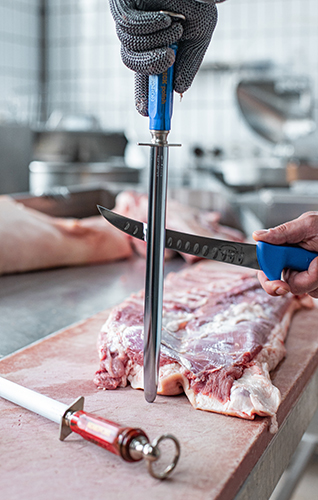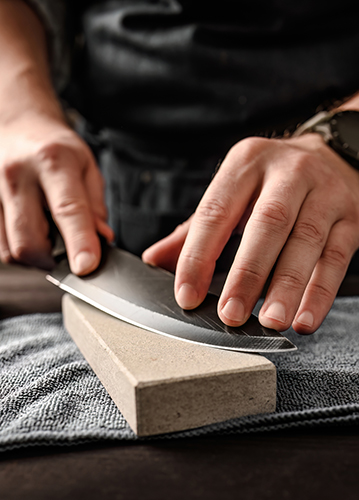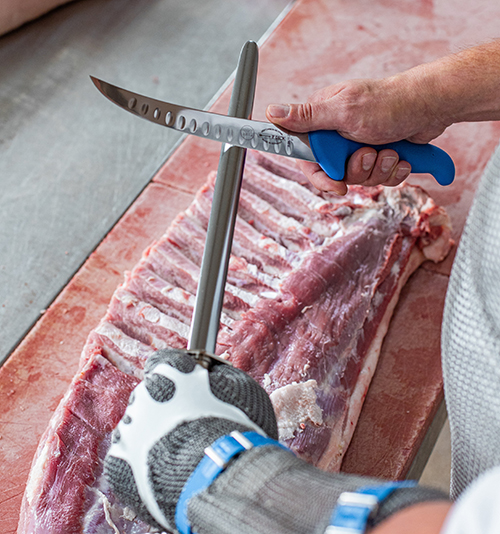


In the culinary world, a sharp knife is more than just a tool - it's an extension of the chef's hand. Whether you're finely chopping vegetables or slicing through a tough piece of meat, the sharpness of your knife can significantly impact your efficiency and the quality of your work. But what's the best way to keep your knives in top condition? The debate between using sharpening steels and sharpening stones has been ongoing for years. We'll delve into the advantages and disadvantages of each method, focusing on why sharpening steels could be the best choice for you.

Sharpening steel, often called honing steel or knife sharpening rod, has been a staple in kitchens and workshops for centuries. Originating from the need to maintain a sharp edge on knives, sharpening steel has evolved into a versatile tool with various types and cuts. Whether you're a professional chef or a home cook, understanding how to use sharpening steel is crucial for knife maintenance.
Different types of sharpening steel offer varying levels of abrasion. Each type has unique characteristics and applications, from rough cut to diamond. For instance, a diamond sharpening rod provides a high level of abrasion suitable for extremely dull knives, while a standard steel rod is ideal for daily maintenance.
Sharpening a knife with a rod involves holding the knife at a specific angle and applying consistent pressure. The angle usually ranges between 20 to 30 degrees, depending on the knife and the sharpening steel. Mastering this technique ensures you maintain a razor-sharp edge on your knives, enhancing their longevity and performance.
Cleaning and maintaining your sharpening steel is equally important. After each use, cleaning the rod with warm water and a mild detergent is advisable. Some types of sharpening steel can also be sterilized for added hygiene, especially in professional settings.

Sharpening stones, colloquially known as whetstones, are ancient tools that have stood the test of time. These stones have been used for centuries, from swordsmen to modern chefs to hone various blades. But what makes them so enduring? The answer lies in their versatility and the quality of sharpness they can provide.
Whetstones come in various grits, ranging from extremely coarse to ultra-fine. The lower the grit number, the coarser the stone, and vice versa. This allows for a high level of customization; you can start with a low-grit stone to remove more material and then move to a higher grit for fine-tuning. The materials used to make these stones are equally diverse, including diamond, ceramic, and natural stones like Arkansas or Japanese water stones.
The process of using a whetstone is both an art and a science. Whetstones require a bit more finesse than the more straightforward method of using a sharpening rod. The stone often needs to be wet, although oil-based stones are an exception. The angle at which you hold the knife and the pressure you apply are crucial factors that can affect the quality of the edge. This makes the process slower and more skill-dependent, but many argue that the level of sharpness achieved is unparalleled.
Maintenance of a whetstone is another aspect that sets it apart from sharpening rods. These stones need to be kept flat for effective sharpening. Over time, the middle of the stone can wear down, creating an uneven surface. Flattening the stone is essential to maintain its effectiveness, adding an extra layer of complexity to your knife-care routine. Depending on how you view it, this can be a meditative process for some and a cumbersome chore for others.
The debate between honing and sharpening is as old as the tools themselves. Both methods have legions of supporters and a list of merits that can make choosing between them a daunting task. However, sharpening steel often takes the lead regarding practicality and efficiency.
One of its most significant advantages is the speed at which you can sharpen a knife with a honing rod. Once you've mastered the technique—which involves holding the knife at a consistent angle and applying even pressure—you can maintain a sharp edge in seconds. This is particularly beneficial for professional settings where time is of the essence.
Ease of use is another area where sharpening steel shines. The learning curve for using a honing rod is generally less steep than a whetstone. The design of most sharpening rods includes a handle and a guard, reducing the risk of accidents. This makes it a safer and more accessible option, especially for those new to the knife maintenance world.
When it comes to maintenance, sharpening steel wins hands down. The rod is easier to clean, usually requiring a quick rinse under running water. There's no need for flattening or soaking, as with whetstones. This makes sharpening steel a more practical choice for those who frequently reach for a sharpening tool.
Versatility is the final feather in the cap for sharpening steel. These rods are not limited to kitchen knives; they can be used for hunting knives, pocket knives, and even scissors. This makes them a universal tool for all your sharpening needs, from the kitchen to the great outdoors and even the workshop.

The advantages of using a sharpening steel extend beyond just the convenience factor. One of the primary benefits is efficiency. Learning how to sharpen knives with a rod is straightforward, and once you get the hang of it, you can maintain your knives in less time than it would take using a whetstone.
Safety is another significant advantage. The design of most sharpening rods includes a handle with a guard, minimizing the risk of accidents. This is particularly beneficial for those new to knife maintenance and still learning to use a knife sharpener rod.
Versatility is yet another reason to opt for a sharpening steel. Whether you're dealing with a set of kitchen knives or a collection of workshop tools, a good-quality sharpening rod can handle them all. This is particularly useful for professionals who use a variety of blades in their line of work.
Finally, a sharpening steel is generally more durable and long-lasting than its alternatives. Made from high-quality materials like diamond or high-carbon steel, these rods can withstand frequent use without losing effectiveness. This makes them a cost-effective solution for maintaining your blades.
While a sharpening steel is highly effective, other methods are available for knife maintenance. Some people prefer using manual knife sharpeners, electric sharpeners, or even DIY methods like using the bottom of a ceramic mug. However, it's essential to note that these methods often lack the precision and effectiveness of a sharpening rod.
One common question is, do honing rods sharpen knives? The answer is yes, but sharpness is often superior when using a sharpening steel. The design and material of the rod contribute to this, providing a more consistent and long-lasting edge.
Despite the availability of alternative methods, sharpening steel remains the most reliable and efficient way to maintain your knives. Its ease of use, versatility, and durability make it the go-to choice for professionals and home cooks.
What is the main difference between a sharpening steel and sharpening stone?
A sharpening steel is generally used for honing a knife's edge quickly, while a sharpening stone is used for more precise sharpening and requires more skill and time.
Is a sharpening steel better than a sharpening stone?
Both have their merits, but a sharpening steel is generally faster and easier to use, especially for beginners.
Do I need both a sharpening steel and a sharpening stone?
Having both can be beneficial. A sharpening steel is great for quick honing, while a sharpening stone can provide a more refined edge.
How often should I use a sharpening steel?
It depends on how frequently you use your knives. For regular use, honing with a sharpening steel once a week is generally sufficient.
How do I maintain a sharpening stone?
Sharpening stones need to be flattened regularly and may require soaking in water or oil, depending on the type.
Can I use a sharpening steel on any type of knife?
A sharpening steel is versatile and can be used on most types of knives, but it's always best to check the manufacturer's guidelines.
What are the different types of sharpening stones?
Sharpening stones can be made from various materials like diamond, ceramic, and natural stone, and they come in different grits for varying levels of sharpness.
Is it easier to learn how to use a sharpening steel than a sharpening stone?
Yes, using a sharpening steel is generally considered easier to learn, especially for beginners.
How do I choose between a sharpening steel and a sharpening stone?
Consider factors like your skill level, the types of knives you have, and how often you'll need to sharpen them. A sharpening steel is generally more convenient, while a stone offers more precision.
In conclusion, sharpening steel offers a quick, efficient, and reliable method for keeping your knives in top condition. Its advantages over alternatives like whetstones make it a practical choice for anyone who uses knives regularly. Whether you're a professional chef or a home cook, investing in a good-quality sharpening rod can significantly improve your culinary experience.